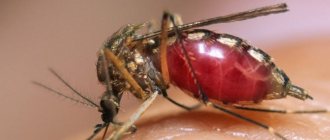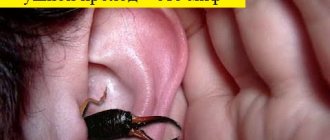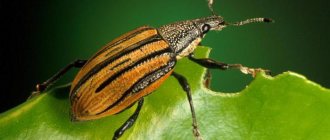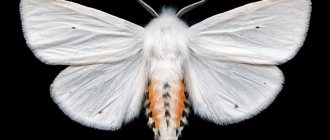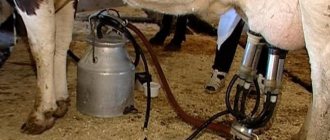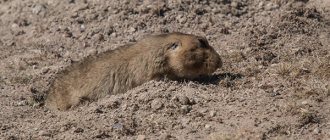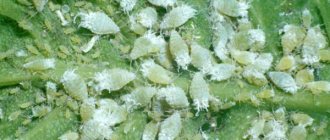Modifications of the oral apparatus
In different groups of insects, the oral apparatus has been modified to better absorb different types of food in different ways. The most specialized and varied types of mouthparts are listed below; they are chosen to demonstrate the richness of the forms assumed by homologous parts and the different ways in which they are used. There are also many other types, and they often represent transitional stages between the types we are considering here. [4]
The type of mouthparts is a systematic character at the order level. In smaller taxa, there are usually no differences in this character: as a rule, only some individual structural features are found. [2]
Gnawing mouthparts
Gnawing mouthparts
Designed for tearing and absorbing more or less solid food. Examples: cockroaches, locusts, grasshoppers, beetles, horntails, sawflies, ants. Some insects that lost such oral apparatus in the adult stage retained it in the larval stage (for example, butterfly caterpillars).
Labrum
Upper lip (labrum). A movable plate that covers other oral organs on top.
Mandibles
Upper jaws, mandibles or mandibles (mandibulae). Solid undifferentiated formations. Predators are armed from the inside with strong and sharp teeth, usually elongated. Herbivorous species have wider mandibles. In social insects they serve for defense and attack and are especially highly developed in the soldier caste (ants, termites).
Ant mandibles
Maxillae
Lower jaws (Maxilla, maxillae). In the original generalized type they consist of 5 parts: cardo, stipes, galea, lacinia, palps (of 5 segments).
Labium
The lower lip (labium) is the second pair of lower jaws fused together. In the original generalized type they consist of 5 parts: chin (postmentum = submentum + mentum), prementum, palps, glossae, paraglossae. Glossae and paraglossae form the apical part of the lower lip, called the ligula or uvula.
Hypopharynx
Subpharynx, or hypopharynx (hypopharynx). It is located under the pharynx and divides the preoral cavity into two sections: anterior and posterior. In the anterior section (cibarium) the oral opening opens. The excretory opening of the salivary glands flows into the posterior section (salivarium).
Gnawing-licking mouthparts [ edit | edit code]
Characteristic of stinging hymenoptera that visit flowering plants to consume nectar. Examples: bees, bumblebees, wasps. Their upper jaws and upper lip are designed in the same way as in the gnawing mouthparts. They use their mandibles to capture prey (wasps) and dig nests in the ground (sand wasps), form pieces of wax (bees) or other materials to build their nests (paper wasps). The maxillae and lower lip have developed into a long retractable organ (usually called the ligule), which serves to penetrate deep into the flower and suck out nectar from there.
Sucking mouthparts
1 – Structure diagram 2 – Mouthparts of a butterfly
Designations in both pictures: VG - upper lip, NG - lower lip, LF - lower jaws (proboscis).
Gnawing type functions
The gnawing oral apparatus serves its owner not only as an effective organ of nutrition , but also as a means of protection from predators and trespassers: the antagonist muscles that move the mandibles apart in the horizontal plane have remarkable strength, because it is with the help of them that ants can hold objects of several thousand times heavier than yourself. Such a bite is not dangerous (if the beetle does not have poisonous glands), however, it is quite painful and can distract the enemy for a short time, giving the beetle the opportunity to escape unharmed.
The food of beetles with a gnawing type of structure often
becomes smaller beetles and (examples of such predators are ground beetles, ladybugs), parts of plants or the entire plant (many species of caterpillars, grasshoppers, locusts). Polite or paper wasps use their mandibles to tear off small sections of bark and old wood from dry stumps, then “chew” them, thoroughly mixing them with sticky saliva and turning them into a kind of sticky papery mass that is quite strong and hard when dry. The nest will subsequently be built from it.
The structure of the oral apparatus varies greatly among different beetles due to dietary preferences, habitat, size of the beetle and its place in the ecological niche. However, the above general scheme will be true for any beetle.
Licking mouthparts
Tahina
A special modification is the muscoid type of oral apparatus, which arose in flies and is adapted to the consumption of both liquid and solid food. The mandibles and maxillae are reduced, and the remaining organs are transformed into a proboscis. Developed in non-blood-sucking flies, including the housefly.
Representatives
Due to the fact that this structure of the mouthparts is characteristic of many orders of the Fly family (Musca), the licking mouthparts are also called muscoid.
Piercing-sucking mouthparts
Developed in insects for the consumption of liquid food, which need to pierce the food substrate for this. Examples: bugs (bed bugs, water striders), homoptera (aphids, cicadas, scale insects and scale insects), mosquitoes, lice, fleas, thrips, etc.
Dragonfly mask
In the larvae of some species of dragonflies, the lower lip is transformed into a so-called mask - a retractable grasping jaw.
Other types of mouthparts
Filter type
The described varieties belong to the main types of mouthparts, however, among smaller and less numerous orders there are also other modifications. For example, some aquatic larvae, in particular the larvae of many midges (Simuliidae), develop a kind of fan on their heads designed to filter microorganisms. Based on the mechanism of operation, this type of apparatus is called filtering. [4]
Cutting-sucking mouthparts
Developed in horse flies and some other dipterous insects.
Tubular-sucking mouthparts
Characteristic of butterflies in which food intake is not accompanied by puncture of the food substrate.
Reproduction and development of insects
Insects are dioecious animals with sexual reproduction. Individuals that reproduce parthenogenetically (bees) are noted.
There are two main ways of transformation: incomplete (incomplete metamorphosis) and complete (complete metamorphosis).
Incomplete transformation is observed in dragonflies, mole crickets, grasshoppers, mantises, etc. The following stages are distinguished in their development:
egg -> larva -> adult insect (imago)
Incomplete development of an insect using the example of a grasshopper (Reanimator86)
With incomplete metamorphosis, the larvae usually resemble their adult representatives.
A cluster of wingless larvae is called a swarm.
In insects with complete transformation (butterfly, fly, bee, mosquito, beetle, etc.) there are stages:
egg -> larva (or caterpillar) -> pupa -> adult insect (imago)
Full development of an insect using the example of the cockchafer
When fully metamorphosed, the larvae do not resemble adults. The larvae undergo modifications within several days (flies) to several years (chafer beetle).
It is believed that fully metamorphosed insects are better equipped to survive because their larvae feed on food that is different from that of adults (adults). This helps reduce food competition.
What kind of mouthparts do butterflies have?
Butterflies are delicate and beautiful creatures. We often see them sitting on flowers. To feed nectar, a tube-shaped apparatus is needed. These insects do not chew anything. The type of mouthparts of the butterfly is tubular-sucking.
Representatives of the order Lepidoptera
Lepidoptera, or Lepidoptera (from the merger of the words “wing” and “scale” in ancient Greek) is an order of insects distinguished by a dense covering of hair-scales on the wings. Most often they are simply called butterflies, moths or moths.
Archaeologists have found remains proving that butterflies existed during the Jurassic period.
Fossilized remains of a butterfly from the Jurassic period
In everyday life, they use a division into lower and higher butterflies, where the lower are micro-lepidoptera, primitive butterflies, and the higher are macro-lepidoptera day and night butterflies.
Separately, it is worth mentioning how to distinguish daytime from nocturnal insects, with the exception of their lifestyle.
- Day butterfly. When resting, folds its wings flat over its back. More brightly colored than night.
- Moth. In a calm state, it keeps its wings open, partially or completely masking its body. The ratio of body length to wing length is greater than that of diurnal individuals. The antennae are also thicker and more branched.
As for etymology, the Russian name “butterfly” comes from the Old Slavonic “grandmother”. Pagans believed that the souls of dead relatives visited the living, reincarnating as insects. To this day you can hear Old Believers in villages and villages calling them “babuchka”, “grandmother”.
The familiar “moth” is also derived from the Old Slavonic words “to dangle”, “revenge”, which means “to spin around its axis” or “to mix in jerks”.
The word “moth”, according to one version, is derived from the Old Slavonic “grind” meaning “to destroy.” According to another, from the Irish mil meaning “small animal”.
General characteristics of Lepidoptera
Lepidoptera are one of the most numerous orders of insects belonging to the phylum arthropods. A characteristic feature of all representatives of the order is four wings covered with a fine layer of modified scales. Their coloring creates bizarre and unique patterns on the surface.
Butterfly wing under a microscope
If we draw an analogy with other insects, then butterflies are a rather “young” group. The first representatives appeared with the flowering plants in the Cretaceous period.
Butterflies are distributed throughout the world, right up to the border of permafrost. Those species that live in temperate latitudes need wintering. More often, the insect survives the cold period in the form of a pupa, less often - in the adult stage. In the latter case, lepidoptera can migrate over vast distances, gathering in huge flocks.
Monarch Butterfly Migration
More than 15,000 species of butterflies are found in the CIS countries.
Common to our latitudes, urticaria, mourning grass, peacock's eye and buckthorn are able to survive the winter as adults without leaving their native lands. When spring comes, they will be ready to reproduce again.
The butterfly's two faceted eyes are capable of recognizing colors, but unlike humans, they see the world in the ultraviolet part of the spectrum. This feature allows zoologists to control the behavior of flying insects using special lamps and conduct observations at night.
How a butterfly sees the world
Butterflies are an important part of the ecosystem, since many plants are pollinated mainly or only by them. Caterpillars serve as food for many small animals and birds.
There is also a downside - the voracious larvae of butterflies can cause significant damage to vegetable crops and plants used by humans. In some cases, they can leave entire gardens and even forests without leaves.
Types of lepidopteran insects
Zoologists have recorded more than 158 thousand species, subspecies and families of these flying insects.
Lepidopterist entomologists study the butterfly order.
Since the scientific classification system is constantly modified and adjusted, the most understandable is considered to be the one in which all lepidopteran insects are divided into four suborders:
- primary toothed moths;
- trunkless;
- proboscis;
- heterobatmy.
This classification is used by butterfly collectors (lepidopterophilists). Let's look at each suborder in a little more detail.
Toothed moths
The smallest lepidopteran representatives of the species that existed back in the time of dinosaurs. The size of the insect varies from 4 to 15 mm. The gnawing type oral apparatus consists of asymmetrical mandibles, where the upper jaw predominates over the lower jaw. A distinctive feature is the long and large antennae, the size of which is approximately 75% of the size of the wings.
This subgroup includes about 160 species of butterflies. The most famous representatives are Micropteryx calthella.
Small wing of the family Micropteryx calthella
Proboscis
Officially, this species appeared in the systematization of lepidopteran insects relatively recently - in 1967. Until this time, all proboscis moths were classified as toothed moths.
This is the smallest subgroup, which includes only butterflies of the Heterobathmiidae family.
Mourning moth butterfly
Proboscis
One of the largest suborders, including more than 150 thousand species of Lepidoptera. Representatives of the Sailfish family are considered the most famous and sought after among collectors:
- Swallowtail - the wings have an attractive, bright yellow or ash color, over which there is a pattern of black lines. At the moment, the swallowtail is listed in the Red Book as an endangered species of insect.
Swallowtail
- Glory of Bhutan - the upper wings are rounded, and the lower ones have three branches. The color is dark, with red-white-yellow “eyes” that warn predators of danger. Habitat: China, Thailand, Northern India.
Glory to Bhutan
Uncontrolled deforestation in India has led to a sharp decline in the population of the Glory of Bhutan butterflies. Currently, these insects are under government protection.
- Queen Alexandra's birdwing is the largest representative of daytime butterflies on the planet. The wingspan reaches 28 cm. The intricate interweaving of green and black lines in color is reminiscent of a tropical flower or ancient brocade.
Birdwing of Queen Alexandra
In this same subgroup it is worth highlighting insects of the Nymphalina family. Their peculiarity lies in their wide wings with thick and rough veins, as well as in the variety of color options. The following butterflies belong to the order Lepidoptera:
- Admiral - found almost everywhere - from city gardens to mountain peaks. It can be unmistakably recognized by its black wings, with bright red semicircular stripes and white spots.
Admiral
- The day peacock is a long-lived butterfly that can live for a total of about a year. For these qualities, it is often used at exhibitions and even kept at home. In the corner of each of its wings there is a yellow circle, in the center of which there is another one - brown and a light blue outline.
Peacock eye
- Urticaria - feeding on nettle nectar and resting on the leaves of the plant, this butterfly is not afraid of being stung. She got her second popular name - chocolate girl - for her coloring, reminiscent of chocolate-caramel stains.
Hives
Also among the proboscideans, the most famous butterflies are the blueberry and the pied moth.
Device
The butterfly's mouthparts are simple but elegant. The proboscis is formed by highly elongated maxillae, that is, the lower jaws. The mouthparts of a butterfly have both upper and lower lips. They are located, respectively, above and below the proboscis. The upper jaws - mandibles - in Lepidoptera are reduced to tubercles or completely lost. During evolution, the palps of the lower lip were preserved. They consist of three segments and look like additional short antennae.
Proboscis work
The mouthparts of a butterfly are a beautiful formation. The proboscis is tightly curled when at rest.
To feed, the butterfly unfolds it and touches it with the tip of its proboscis in search of food, which it previously felt with its paws. It is on the legs of this insect that the receptors responsible for taste are located.
Some butterflies feed on the nectar of flowers. In this case, the length of their proboscis coincides with the length of the nectar plants on which they often obtain food. These same species of lepidoptera can, if possible, get enough of tree sap or fruit juice.
They will most likely like the jam, various sweets, and fruits left by people. There are species of Lepidoptera that feed on aphid secretions. Some imago species do not feed at all. In such representatives the proboscis is underdeveloped. For example, in Volyanka.
Butterflies with chewing mouthparts
However, not all butterflies have sucking mouthparts. There are species of moths that have gnawing mouthparts. These representatives have developed upper jaws. Butterflies with gnawing mouthparts belong to a separate suborder of Gnawers. They are able to eat rough food. All other representatives belong to the suborder Hobotkov, they have a sucking mouthparts.
Thus, the butterfly has a sucking type of mouthparts. The proboscis is very long, but so that such a formation does not interfere, in a calm state it is curled into several rings. The proboscis is elastic and flexible. It is formed by two lower jaws, each of which has the appearance of a groove.
Systems at the heart of the driving force
To maintain level flight, it is not enough to simply flap your wings up and down. Wings must change angles as they flap to create propulsive force as well as lift. The wings have enough flexibility to rotate, depending on the type of insect. The primary flight control muscles, which also produce the necessary energy, provide this flexibility.
For example, when moving upward, these muscles between the wing joints contract further to increase the angle of the wing. Research using high-speed imaging technology found that the wings followed an elliptical path during flight. In other words, the fly not only flaps its wings up and down, but it also flaps them in a circle, like rowing a boat. This movement is achieved using the core muscles.
The greatest problem faced by small insect species is inertia reaching significant sizes. The air seems to stick to the wings of these small insects and greatly reduces the efficiency of the wing.
Therefore, some insects, whose wing size does not exceed one millimeter, must flap their wings up to 1000 times per second to overcome inertia.
The researchers believe that even this speed is not enough to lift the insect, and that they are also using other systems. As an example, consider a species of small parasites, Encarsia, that use the so-called “slam and leave” method. With this method, the wings flap together at the top of the stroke and then separate. The leading edges of the wings, where the hard vein is located, separate first, allowing air to flow through the internal high-pressure zone. This air flow creates a vortex, aiding the thrust of the flapping wings. (Encyclopedia of Science and Technology, p. 2679)
There is another special system created for insects to maintain a stable position in the air. Some flies have only a pair of wings and round organs on their backs called halteres. The halteres during flight produce beats like a normal wing, but do not produce any lift as wings do. The halteres move when movement changes, and prevent the insect from going astray. The system is similar to the gyroscope used for navigation in modern aircraft. (See Why does a Fly fly like a Fly?)
insects can fold their wings. When folded, they are easy to maneuver with the help of auxiliary parts at their tips. The US Air Force created an aircraft with folding wings after being inspired by this example. While bees and flies can fold their wings completely on themselves, such an airplane can only fold one half of the wing onto the other half. Source.
The structure of the mouthparts of beetles
The head of a beetle, and in particular the mouthparts, consists of several components:
- Upper lip;
- Underlip;
- Gnawing organs;
- Palpi;
The upper lip is called the labrum and is a fold of skin that covers the oral apparatus at rest. It contains many sensitive taste and tactile receptors. With their help, the insect determines whether objects are edible. Underneath it lie the chewing organs—mandibles and maxillae (upper and lower jaws, respectively).
Their number is equal, that is, how many mandibles a beetle has, so many maxillae. They contain serrated processes that help the jaws grab prey, tear small pieces from it and grind them as long as it takes until they get manageable pieces. Then the food is ground and, with the help of maxil and labium, carried deeper into the mouth, as close to the esophagus as possible.
Palps of different types located on the head (labial, maxillary and others) provide the beetle with the necessary information about what is happening in the world around it, since most insects have rather poor vision. The palps are capable of detecting the odors of potential partners or danger, air vibrations, temperature changes, they can also work as an organ of touch, examining an unfamiliar substrate or food.
general information
The structure of all beetles, of course, varies, but in general terms it can always be described. Most beetles have a separate head, which most likely contains antennae, eyes and mouthparts. Behind the head is the next part of the body - the chest. It is less mobile relative to the head. The first and second pairs of legs are located on the chest.
Between the sections of the abdomen and chest there are wings.
, which has the function of protecting against external damage. These wings often develop in beetles during the pupal stage, forming from initial tissues. Many people are often interested in the question: “How many wings does a beetle have?” Beetles can have no more than two wings, that is, no more than one pair.
The entire body of the beetle is covered with a hard chitinous covering, which acts as an exoskeleton. This cover also protects the insides of the beetle from mechanical damage. The hard elytra are also made from the same material, which cover the beetle’s wings in a state of rest and protect them from damage.
When to see a doctor
In most cases, mosquito bites are tolerated relatively well, provided that adequate treatment is provided in a timely manner. After a few days, inflammation and discomfort disappear without specialized treatment. There are several following conditions in which a visit to a doctor is indicated:
- A large number of bites caused by insects over a relatively short period of time.
- Children under 3 years of age.
- Localization of bites in the face and neck, which increases the risk of toxic compounds, mediators of allergic and inflammatory reactions directly into the brain tissue.
- The appearance of the first signs of the development of severe systemic allergic reactions.
- Development of signs of human infection with diseases whose pathogens are carried by mosquitoes (headache, severe intoxication, enlargement of regional lymph nodes, their soreness).
The mechanism of operation of the fly's mouthparts
Flies feed mainly on liquid nutrient substrates and finely dispersed food suspensions, for example, products of decomposition of organic residues. The liquid is absorbed by the proboscis, entering the food canal through thin capillary tubes on the surface of the lower lip.
Some types of solid food, such as sugar, are also consumed by flies using this proboscis. This is done as follows: first, the fly secretes a drop of saliva onto the surface of the food, which partially dissolves and is then absorbed into the mouth as a liquid.
Appearance and internal structure
At first glance, the body structure of a fly seems simple, but in fact, many institutes have been studying these insects for a long time. The body of a fly consists of three parts: head, thorax and abdomen. The lower part of the head has a yellow tint. The following organs are located on it:
- Eyes. In the fly they are quite large and consist of many small simple eyes that form a faceted network. The image obtained using facets has the appearance of a mosaic.
- Oral apparatus. Insects have powerful jaws and a proboscis. Food enters through the lobes of the upper and lower lips. A large number of tubules connect at the central point of the proboscis. In species that feed on blood, the structure of the oral apparatus contains sharp plates with which the insect pierces the skin of the prey.
- Mustache. This organ helps to navigate in space and smell. The antennae of females and males may differ.
The chest has three segments, the second segment being the most developed. On the chest there are 3 pairs of limbs, which consist of 5 segments. The legs of flies are equipped with developed muscles, claws and suckers. When the fly walks, the pads of its feet secrete a sticky liquid. The paws perform another function - they analyze the quality and taste of food.
The front pair of wings is well developed, has a membranous structure, the hind wings are deformed and form halteres. With the help of these appendages, the fly can hover in the air and maintain balance.
The cylindrical abdomen consists of 10 segments. The chitinous shell of flies tends to stretch when saturated and during pregnancy.
The most important internal organs are located in the abdomen. The reproductive system is represented by ducts, accessory glands, as well as eggs or testes, depending on the gender of the individual. External appendages differ from species to species.
Females lay clutches of eggs; their number per clutch can range from 70 to 150, depending on the species. In the family of corpse flies there are viviparous ones.
The digestive system is represented by the goiter, intestines, Malpighian vessels and excretory tubules. Food is digested before absorption; for this, the insect introduces a special digestive secretion into it.
The respiratory organs include a large number of tracheae, which are distributed throughout the body. Their opening to the outside is ensured by spiracles.
The brain is made up of many neurons. The circulatory system includes the heart, aorta, pterygoid muscle and dorsal vessel. Blood is colorless and transports nutrients.
Head structure
The individual parts of the fly's head have their own names:
- forehead - located between the eyes, at the top it turns into the crown, at the bottom of it there are antennae;
- the fly's face is located below the whiskers and looks like a facial plate bounded by the forehead and frontogenal suture;
- there are cheeks under the eyes;
- the back surface of the head is convex or flat (in some species it is concave);
- the eyes are convex faceted, formed from many facets; in males and females the facets are different - in the former they are holaptic and very close together; eye color varies between species;
- in the oral cavity there is a proboscis instead of the lower lip with sucking lobules at the end, here the salivary gland channel passes;
- The fly's jaws (upper and 1 pair of lower) are atrophied.
The organs of smell and taste are much more advanced and subtle compared to humans. The sharpness and their cricketing ability are associated with a large number of “nostrils,” although the olfactory organs are separated from the respiratory organs and are located on the antennae; some species of dipterans also sense taste with their paws, or rather, with their last segments on the legs.
But the ears of a fly are receptors - nerve cells that respond to external stimuli (sounds, temperature, light, vibration, etc.).
The structure of a fly's head
Important!
The structure of a fly's eyes is unique and has served as a model for scientists to make discoveries. Huge spherical organs of vision consist of several thousand facets, similar to spyglasses. Each of them sees a certain piece of the surrounding world, and its image is then transmitted to the brain and puts together a “overall picture” from the mosaic. Thus, the fly has a full 360° view and quickly reacts to any movement around it.
Recommendations
- Richards, O.W.; Davis, R. (1977). Imms General Textbook of Entomology: Volume 1: Structure, Physiology and Development
.
Berlin: Springer. ISBN 0-412-61390-5.[ page needed
] - [unreliable source?
] - Mouthparts of insects
- Insect Mouthparts - Amateur Entomological Society (AES)
- Structure and functions of the oral apparatus of insects
- "Hymenoptera: ants, bees and wasps", CSIRO
, retrieved 8 April 2012 - Heppner, John B. Richman, David B; Naranjo, Stephen E; Habeck, Dale; Asaro, Christopher; Boev, Jean-Luc; Baumgaertner, Johann; Schneider, David S; Lambdin, Paris; Cave, Ronald D. Ratcliffe, Brett K.; Heppner, John B. Baldwin, Rebecca W.; Scherer, Clay W; Frank, J. Howard; Dunford, James S; Somme, Louis A; Richman, David. B; Krafsur, E. S.; Crooker, Allen; Heppner, John B. Capinera, John L; Menalled, Fabian D; Liebman, Matt; Capinera, John L; Turquoise, Peter E. A; Hoy, Marjorie A.; Lloyd, James E; Siwinski, John; and others. (2008). "Silkworm Moth (Lepidoptera: Bombycidae)". Encyclopedia of Entomology
. pp. 3375–6. Doi:10.1007/978-1-4020-6359-6_4198. ISBN 978-1-4020-6242-1. - Walter Reuther (1989). The Citrus Industry: Crop Protection, Postharvest Technologies, and the Early History of Citrus Research in California.
. UCANR Publications. P. 64–. ISBN 978-0-931876-87-5. - Mehlhorn, Heinz (2001). Encyclopedic reference book of parasitology: biology, structure, functions
. Springer Science & Business Media. p. 310. ISBN 978-3-540-66819-0.
